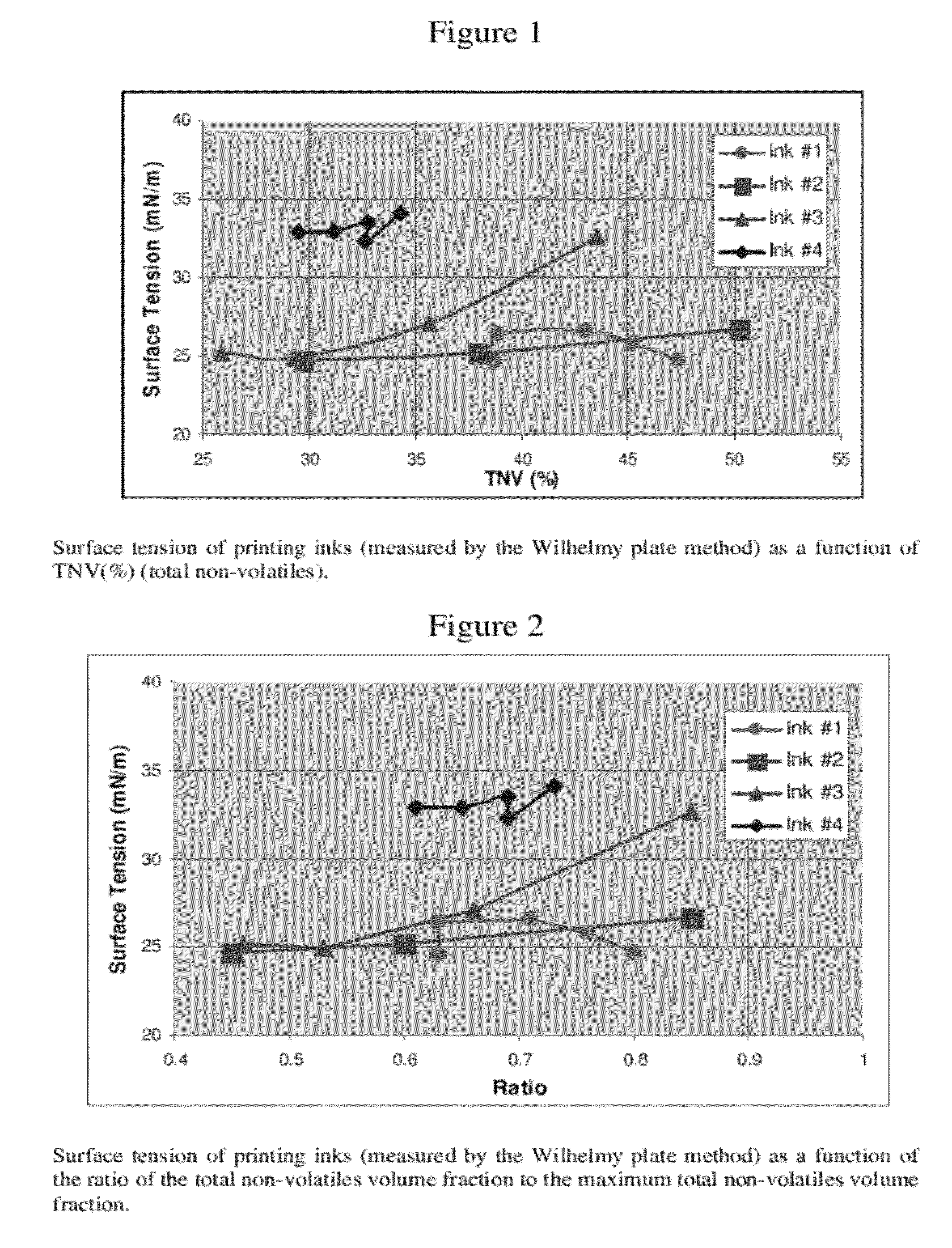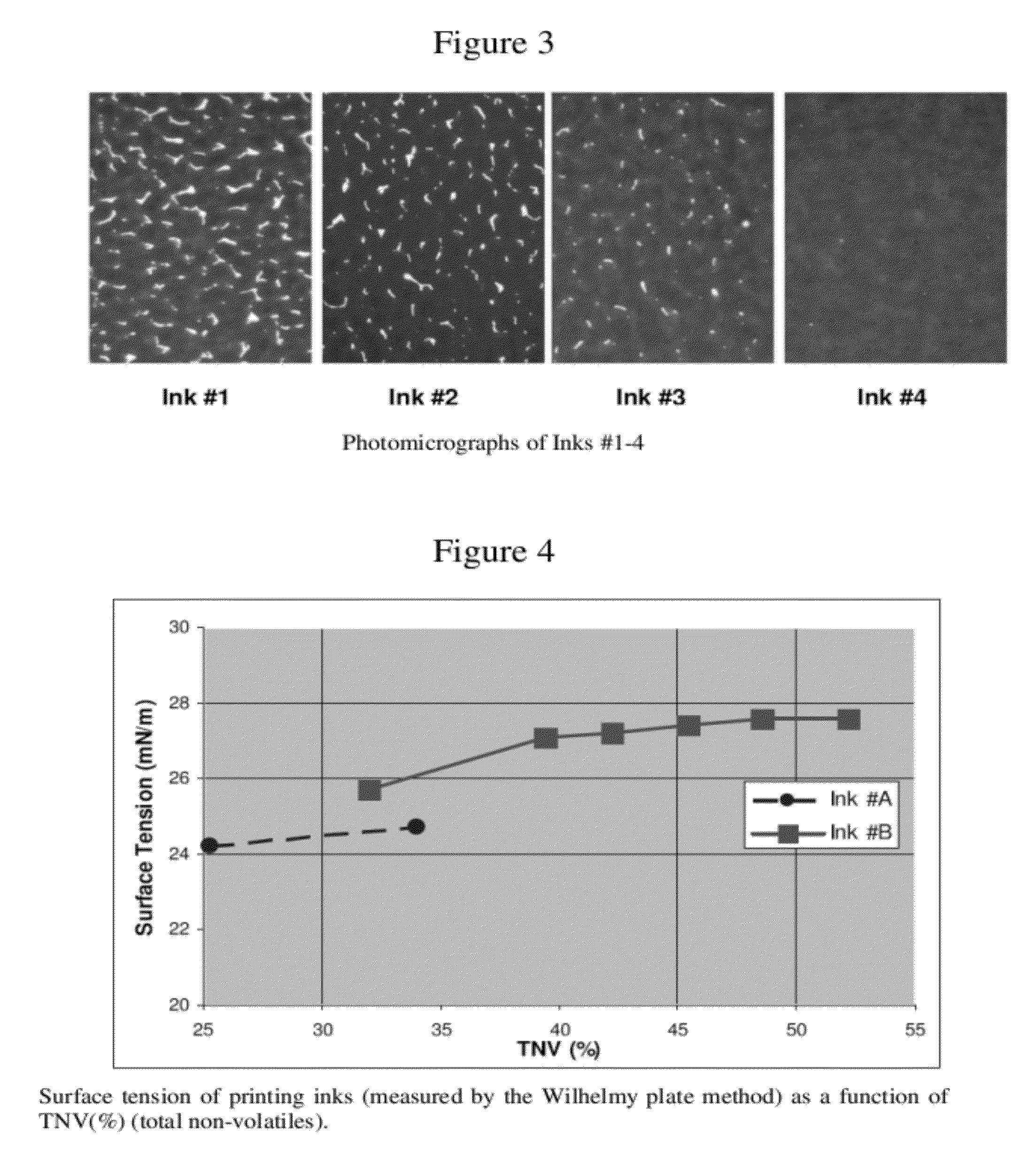Surface tension of inks for high speeding printing
a technology of ink surface tension and printing plate, which is applied in the direction of printing, coating, inks, etc., can solve the problems of short time needed for the ink to travel from the anilox-plate nip to the printing nip, print defects, and inability of the ink to wet out the surfaces of the printing plate and/or substrate, etc., and achieve the effect of controlling the surface tension
- Summary
- Abstract
- Description
- Claims
- Application Information
AI Technical Summary
Benefits of technology
Problems solved by technology
Method used
Image
Examples
example-1
[0046]Four flexographic inks with different pinholing performances were investigated. The inks are identified below as Inks 1, 2, 3, and 4. The inks' compositions are listed in Table 1.
TABLE 1Ink 1Ink 2Ink 3Ink 4Solventsn-Propyl alcoholn-Propyl alcoholn-Propyl alcoholn-Propyl alcoholn-Propyl acetaten-Propyl acetaten-Propyl acetatePropylene glycolIsopropyl acetateDiacetone alcoholDiacetone alcoholmonoalkyl etherPropylene glycolPropylene glycolPropylene glycolDiacetone alcoholmonoalkyl ethermonoalkyl ethermonoalkyl etherDipropylene glycolmonoalkyl etherResinsPolyamideRosin EsterPolyurethaneRosin esterNitrocellulosePolyamidePolyamide
[0047]The choice of specific solvents and actual percentages are developed by consideration of the following two guiding principles: solubility behavior of resin blends in the solvent combinations throughout drying process and the evaporative profiles of the combined solvent blends define the evolution of composition.
[0048]Surface tensions of these inks wer...
example-2
[0051]Two blue inks with different pinholing performances were investigated. The inks are identified below as Inks A and B The inks' compositions are listed in Table 3.
TABLE 3Ink AInk BSolventsn-Propyl Alcoholn-Propyl AlcoholEthyl Acetaten-Propyl Acetaten-Propyl AcetatePropylene GlycolPropylene Glycol Monoalkyl EthermonoalkylDipropylene Glycol MonoalkylEther AcetateEtherPropylene GlycolMonoalkylEtherResinsNitrocelluloseNitrocellulosePolyurethanePolyurethaneEpoxy
[0052]Surface tensions of these two inks were obtained at various total non-volatiles volume fractions (vol % TNV). The solvents were extracted using a rotovap to increase the total non-volatiles fraction and simulate the drying process after the transfer of the ink. The Wilhelmy plate method was carried out. The surface tensions of the two inks were obtained and are shown in FIG. 4, which plots the surface tension in mN / m as a function of TNV (%) (total non-volatiles) where TNV (%) (total non-volatiles) denotes the total non...
PUM
| Property | Measurement | Unit |
|---|---|---|
| surface tension | aaaaa | aaaaa |
| surface tension | aaaaa | aaaaa |
| surface tension | aaaaa | aaaaa |
Abstract
Description
Claims
Application Information
 Login to View More
Login to View More - R&D
- Intellectual Property
- Life Sciences
- Materials
- Tech Scout
- Unparalleled Data Quality
- Higher Quality Content
- 60% Fewer Hallucinations
Browse by: Latest US Patents, China's latest patents, Technical Efficacy Thesaurus, Application Domain, Technology Topic, Popular Technical Reports.
© 2025 PatSnap. All rights reserved.Legal|Privacy policy|Modern Slavery Act Transparency Statement|Sitemap|About US| Contact US: help@patsnap.com



